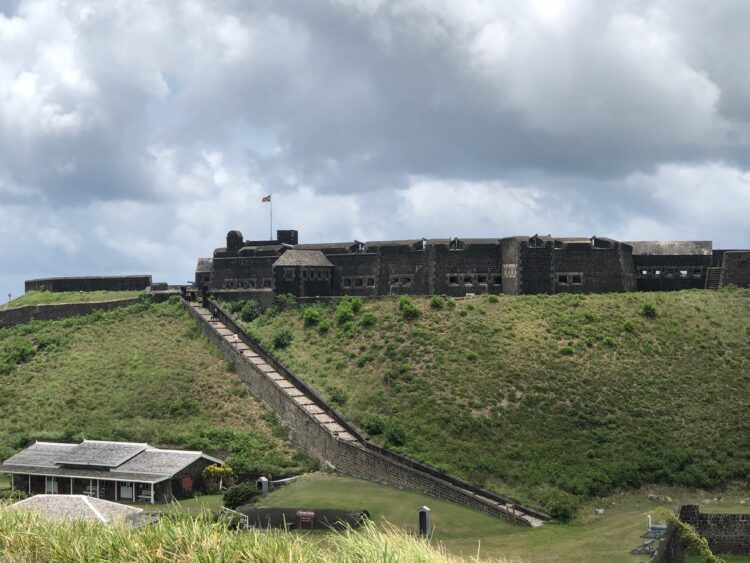Written by my husband, Steve:
The best way to learn about a people, a culture, a country, or a particular place is to experience it daily for an extended period of time. My fortunate two years as the Manager of Brimstone Hill Fortress National Park afforded me a seldom glimpsed view into some of the more arcane and unusual histories of that Park.
Brimstone Hill Fortress is situated on an 800-foot-tall volcanic plug. Fortifications, battlements, and associated structures are, however, located from the very base to the very top. A short way along the park road, now cleared of tropical vegetation, is the massive lime kiln. This is where the lime-used for mortar in the construction of the fortress was fired.
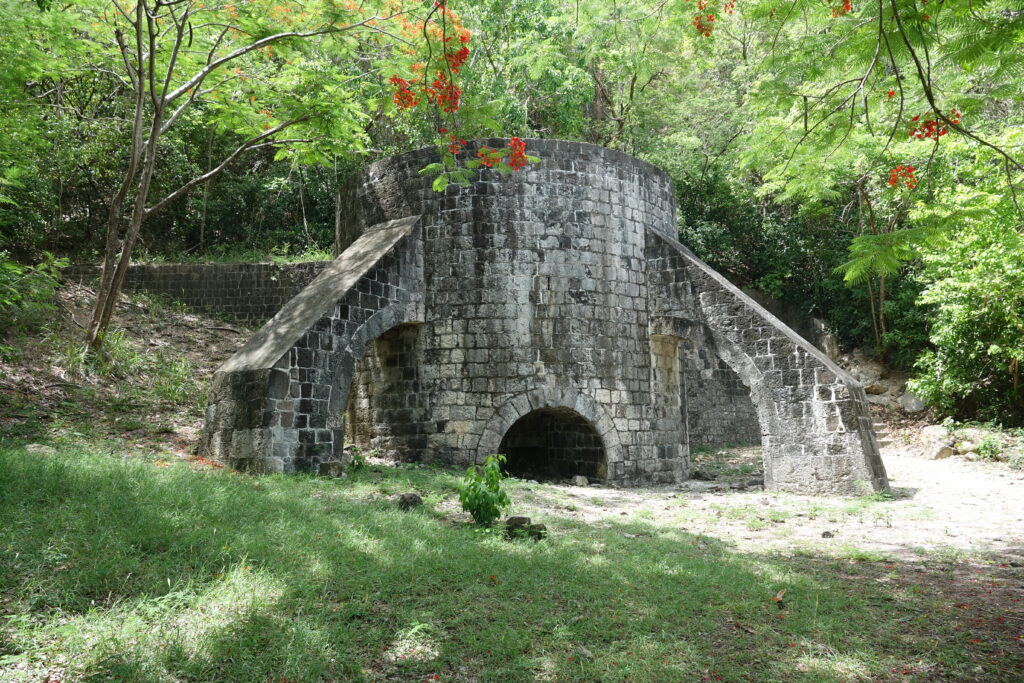
 As you slowly snake along and up the road, you begin to encounter more and more fortress related structures. Massive walls – you drive through the wall on two occasions, redans and the several bastions: Magazine, Orillon, and finally the Prince of Wales. You pass ruins of various quarters, both military and private, water tanks, and half-buried magazines before finally arriving at the Parade Ground (now the parking area). The view of the Caribbean, as well as the imposing fortifications, is incredible. Arrayed around you are the canteen and reconstructed quartermaster’s building and residence, and the ruins of the Infantry Officers Quarters, the Artillery Officers Quarters, and the Jumbie Barracks. Above you, at the top of a long, wide, gently sloping stairway, is the Citadel or Fort George. At the opposite end of the Parade Ground, above the Artillery Officer’s Quarters, is a man-altered peak that was originally planned to house yet another fort-Fort Charlotte; a twin to Fort George. This was my daily workplace for two years.
As you slowly snake along and up the road, you begin to encounter more and more fortress related structures. Massive walls – you drive through the wall on two occasions, redans and the several bastions: Magazine, Orillon, and finally the Prince of Wales. You pass ruins of various quarters, both military and private, water tanks, and half-buried magazines before finally arriving at the Parade Ground (now the parking area). The view of the Caribbean, as well as the imposing fortifications, is incredible. Arrayed around you are the canteen and reconstructed quartermaster’s building and residence, and the ruins of the Infantry Officers Quarters, the Artillery Officers Quarters, and the Jumbie Barracks. Above you, at the top of a long, wide, gently sloping stairway, is the Citadel or Fort George. At the opposite end of the Parade Ground, above the Artillery Officer’s Quarters, is a man-altered peak that was originally planned to house yet another fort-Fort Charlotte; a twin to Fort George. This was my daily workplace for two years.
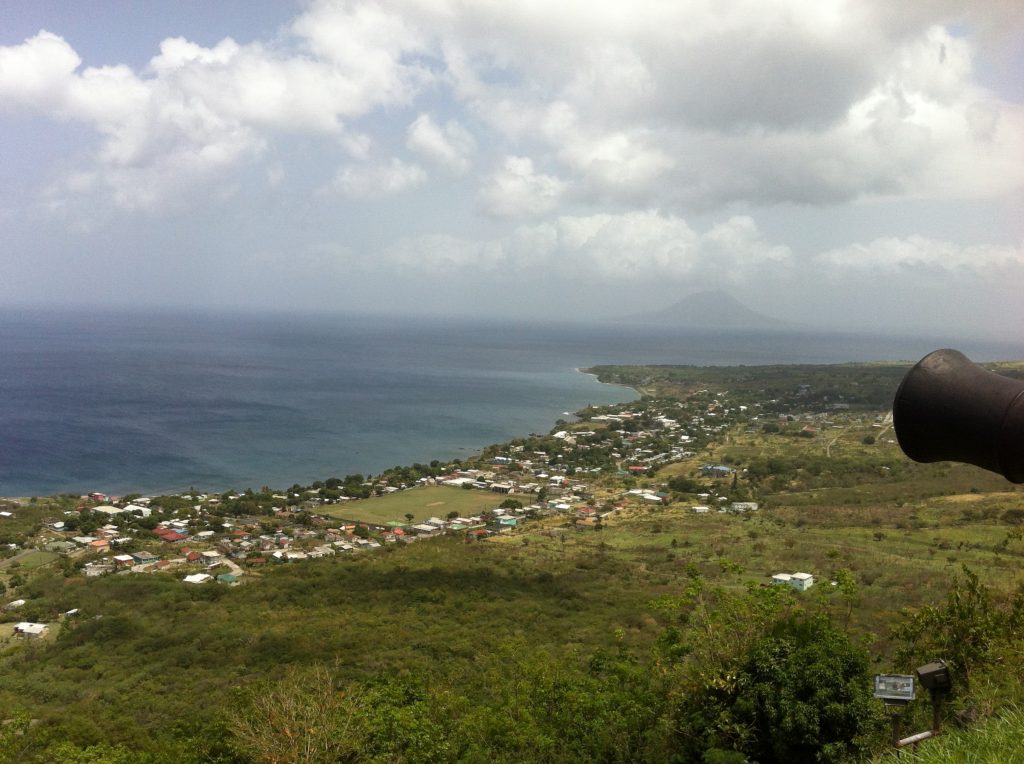
 The stairway to Fort George has extremely low steps, is very gently sloping, and is exceedingly wide. As you ascend, you immediately notice that evenly spaced along the protecting, waist-high walls, are inverted cannons embedded within. Your first thought might be; “Wow, a fort with architectural ornamentation!” But you’d be wrong. It turns out that sometimes, during the process of casting a cannon, they would crack and become useless for their intended purpose. However, their great weight, in conjunction with the already sizable investment, demanded that the Board of Ordnance find alternate uses for them. So, they were loaded on ships with the good cannons and sailed as additional ballast. When new guns arrived, some needed to be hauled up to Fort George. The embedded cannons were rigged with block and tackle, the ropes looped around the cannon, allowing the soldiers to more easily pull them up. The shallow steps and wide stairs also aided in this effort.
The stairway to Fort George has extremely low steps, is very gently sloping, and is exceedingly wide. As you ascend, you immediately notice that evenly spaced along the protecting, waist-high walls, are inverted cannons embedded within. Your first thought might be; “Wow, a fort with architectural ornamentation!” But you’d be wrong. It turns out that sometimes, during the process of casting a cannon, they would crack and become useless for their intended purpose. However, their great weight, in conjunction with the already sizable investment, demanded that the Board of Ordnance find alternate uses for them. So, they were loaded on ships with the good cannons and sailed as additional ballast. When new guns arrived, some needed to be hauled up to Fort George. The embedded cannons were rigged with block and tackle, the ropes looped around the cannon, allowing the soldiers to more easily pull them up. The shallow steps and wide stairs also aided in this effort.
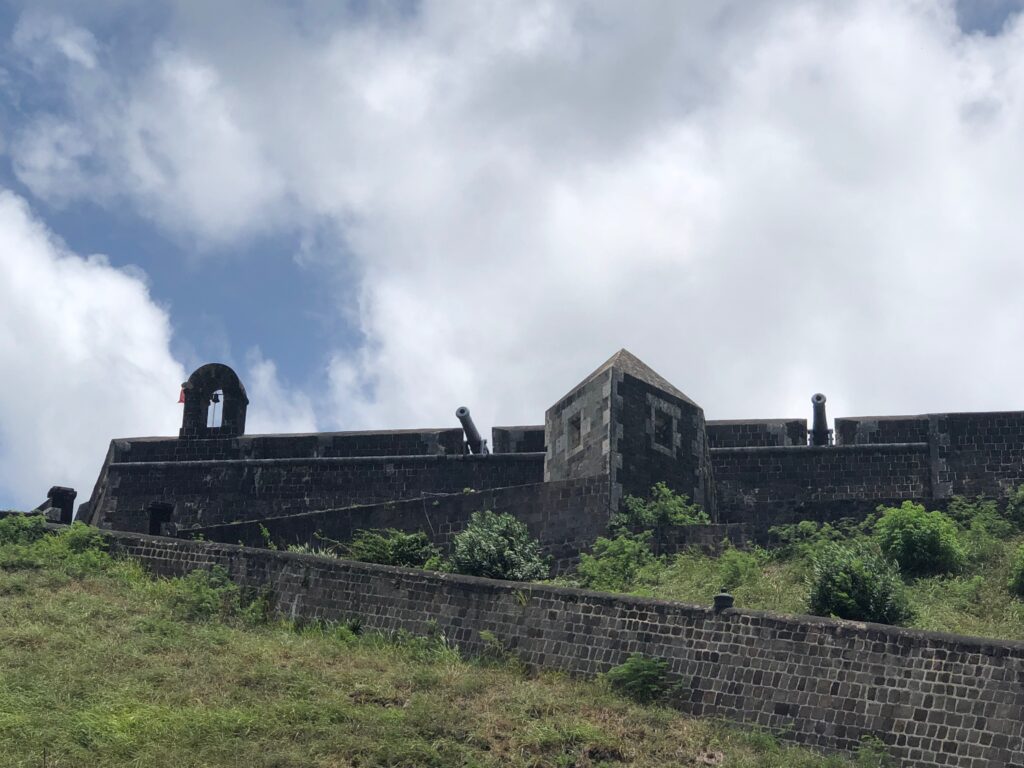
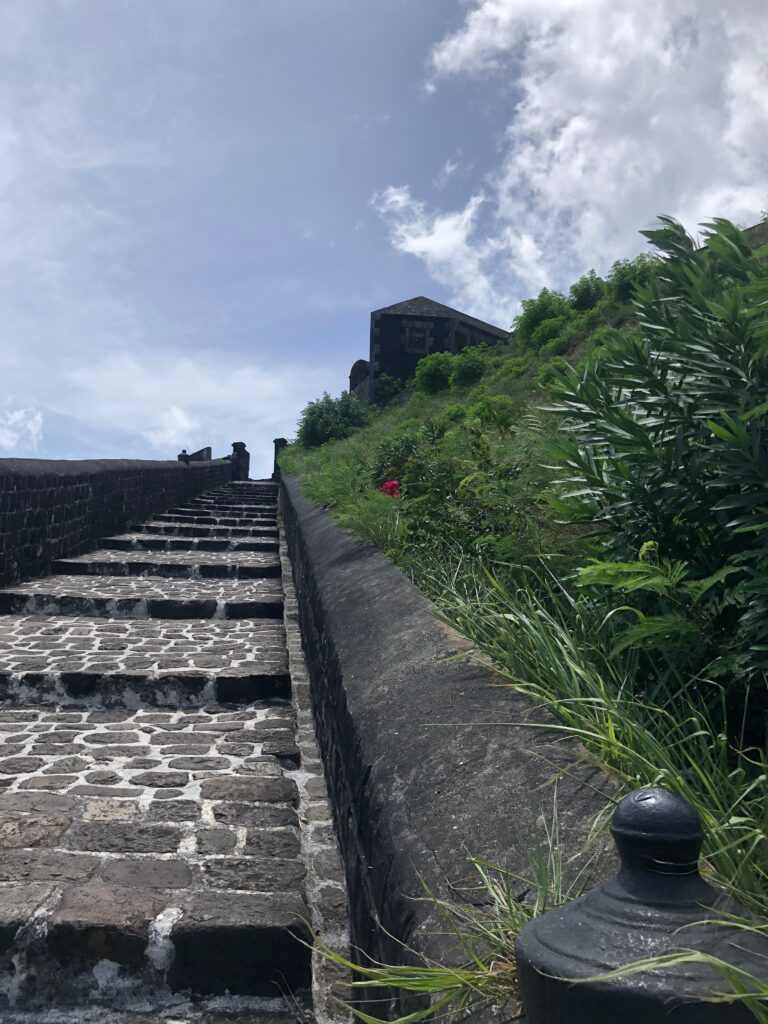 At the top of the stairs is the Western Place of Arms (yes, there is also an Eastern Place of Arms!) To the right is a dry moat and a permanently lowered drawbridge. Walk through a short, downwardly sloping tunnel and you arrive in the courtyard of Fort George. Arrayed around are numerous casemates (fortified gun emplacement or armored structure), most of which now house the museum. Some have upstairs and downstairs so that soldiers could fire their muskets both at ground level and from above. All also acted a living quarters. In one corner was the fort’s “necessary”, or bathroom. It is a large room with a curving, 10-12-foot-deep trench. During the days of its use, planks were placed across the trench onto which the men would sit to do their business. The design was such that, during the frequent rains, a portion of the rainwater would be collected and diverted into the trench and washed out of the fort and over the hillside. Adjacent to the necessary was the kitchen. The relationship between cleanliness and disease was not yet well understood in the late 18th century, so there was no concern with its placement next to the bathroom. In fact, the thinking was to place all of the “services” in one location-there was also a small magazine in the same corner, and the active fortifications in the rest.
At the top of the stairs is the Western Place of Arms (yes, there is also an Eastern Place of Arms!) To the right is a dry moat and a permanently lowered drawbridge. Walk through a short, downwardly sloping tunnel and you arrive in the courtyard of Fort George. Arrayed around are numerous casemates (fortified gun emplacement or armored structure), most of which now house the museum. Some have upstairs and downstairs so that soldiers could fire their muskets both at ground level and from above. All also acted a living quarters. In one corner was the fort’s “necessary”, or bathroom. It is a large room with a curving, 10-12-foot-deep trench. During the days of its use, planks were placed across the trench onto which the men would sit to do their business. The design was such that, during the frequent rains, a portion of the rainwater would be collected and diverted into the trench and washed out of the fort and over the hillside. Adjacent to the necessary was the kitchen. The relationship between cleanliness and disease was not yet well understood in the late 18th century, so there was no concern with its placement next to the bathroom. In fact, the thinking was to place all of the “services” in one location-there was also a small magazine in the same corner, and the active fortifications in the rest.
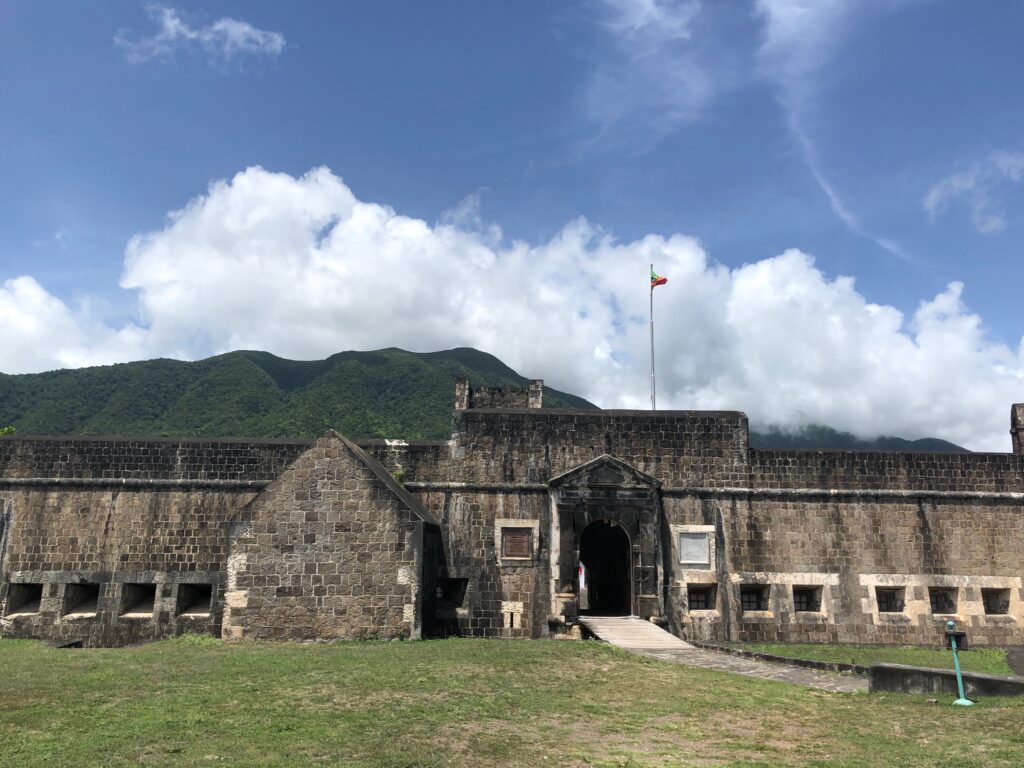

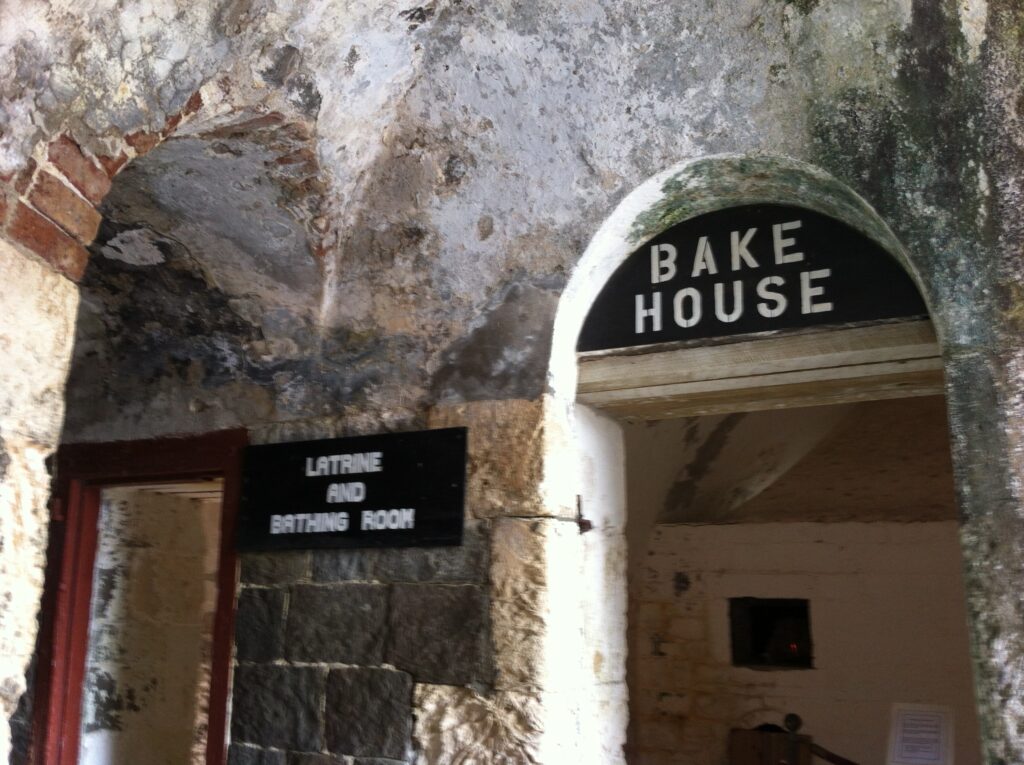 Between 16 and 24 men lived in each of the casemates, some even with wives and children. Hammocks came out at night and blankets or sheets acted as walls for any family units in residence. My favorite casemate was the one in which bats lived-we sold the guano they produced to Rastafarian farmers on the island-as they used only organic fertilizers!
Between 16 and 24 men lived in each of the casemates, some even with wives and children. Hammocks came out at night and blankets or sheets acted as walls for any family units in residence. My favorite casemate was the one in which bats lived-we sold the guano they produced to Rastafarian farmers on the island-as they used only organic fertilizers!
Above the central courtyard and casemates is the gundeck. Cannons, which were spiked and thrown down the hill when the fort was abandoned in 1854, have been remounted. A very interesting story associated with that remounting has to do with Fort Ticonderoga in New York state. In the 1930’s an effort to renovate/restore Fort Ticonderoga was begun. Sometime into that effort it was realized that they did not have any or enough cannons, and so they began looking for sources of genuine and historically accurate period cannons. That search led them to St. Kitts and Brimstone Hill. A deal was struck with the British government (St. Kitts was still a British colony). In exchange for the purchase of the needed cannons, the representatives from Fort Ticonderoga would recover and return the remaining cannons to their original locations throughout the fortress. If you ever visit Fort Ticonderoga, you’ll know you’re looking at original ordnance from Brimstone Hill.
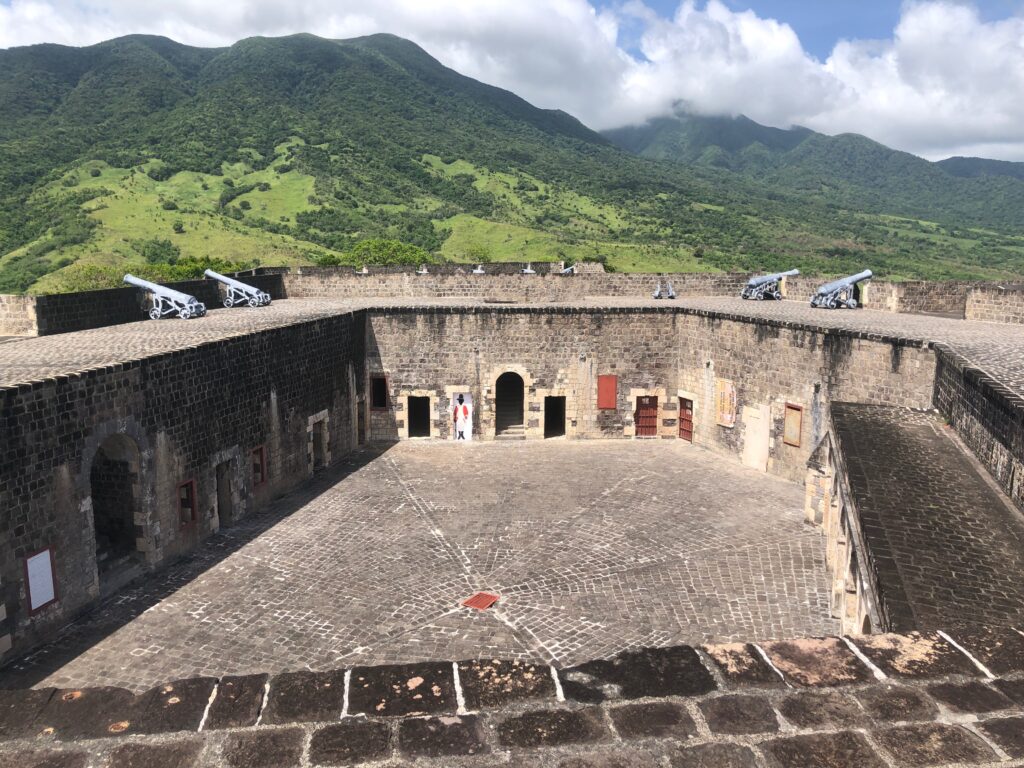 The entire gundeck is wide, flat, and smooth. Each cannon had a crew of 8 soldiers, so plenty of room was needed to accommodate them all. Plus, the recoil of the cannon when fired was significant. You didn’t really want to have one go flying off the deck and into the courtyard because of lack of space. At the base of the outer wall of the gundeck is a shallow, paved ditch. Not surprisingly, because of Brimstone Hill’s origins and location, there is no source of fresh water. All necessary water is collected from the frequent rains. All rain falling on the gundeck drained into that encircling ditch and directed through an intricate drainage system to a large tank located below the courtyard. If you look at the courtyard from the gundeck, you immediately realize that you are looking at a large water collection system. When I worked there, we were still using the original tank as a source of water for flushing the modern toilets-18th century know-how for 20th century tasks. I even spent one leisurely day measuring the surface area of the gundeck and courtyard to see how much rain it would take to fill the tank and flush the necessary!
The entire gundeck is wide, flat, and smooth. Each cannon had a crew of 8 soldiers, so plenty of room was needed to accommodate them all. Plus, the recoil of the cannon when fired was significant. You didn’t really want to have one go flying off the deck and into the courtyard because of lack of space. At the base of the outer wall of the gundeck is a shallow, paved ditch. Not surprisingly, because of Brimstone Hill’s origins and location, there is no source of fresh water. All necessary water is collected from the frequent rains. All rain falling on the gundeck drained into that encircling ditch and directed through an intricate drainage system to a large tank located below the courtyard. If you look at the courtyard from the gundeck, you immediately realize that you are looking at a large water collection system. When I worked there, we were still using the original tank as a source of water for flushing the modern toilets-18th century know-how for 20th century tasks. I even spent one leisurely day measuring the surface area of the gundeck and courtyard to see how much rain it would take to fill the tank and flush the necessary!
We had access to extensive records concerning the design, construction, and occupation of Brimstone Hill. One eye opening discovery was that during its entire 164-year history, the sick call of soldiers varied between 25 and 40%. The first reason was incredulous but true-these British troops, stationed in the tropics of the Eastern Caribbean, were required to wear the famous (wool) redcoats! No wonder they suffered from heat exhaustion.
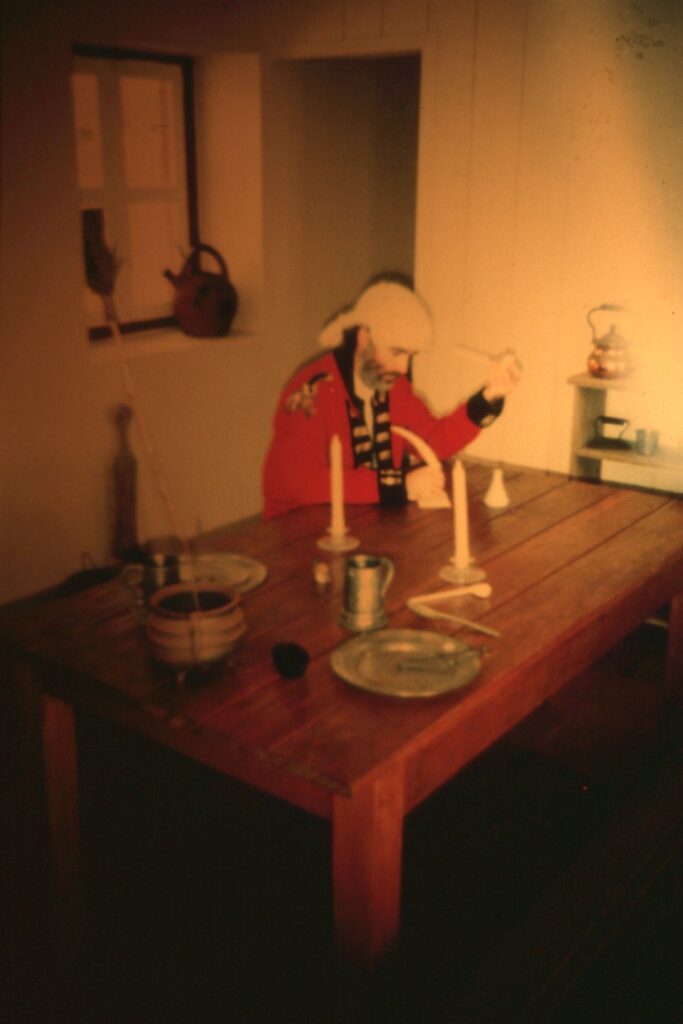 They also suffered from all of the maladies of the tropics including malaria and yellow fever. And don’t forget that the necessary in the Citadel was adjacent to the kitchen. Washing hands was not a common practice then. The soldier’s diet was also an issue. In their desire to minimize costs, the British military decreed that they were only required to provide a loaf of bread and a pint of rum a day to a soldier. Anything else they might wish to eat was up to them. From those records, from oral histories, and from contemporary drawings, we know that some soldiers (or their wives) had gardens and that there were most likely permanent markets just outside the walls of the fortress supplying fresh fruit, meat, and vegetables.
They also suffered from all of the maladies of the tropics including malaria and yellow fever. And don’t forget that the necessary in the Citadel was adjacent to the kitchen. Washing hands was not a common practice then. The soldier’s diet was also an issue. In their desire to minimize costs, the British military decreed that they were only required to provide a loaf of bread and a pint of rum a day to a soldier. Anything else they might wish to eat was up to them. From those records, from oral histories, and from contemporary drawings, we know that some soldiers (or their wives) had gardens and that there were most likely permanent markets just outside the walls of the fortress supplying fresh fruit, meat, and vegetables.
One of my ongoing projects was the removal of vegetation from old ruins both to expose them to view and to slow down their deterioration. About a month after clearing a grove of tamarind trees below the Adjutant Officer’s Quarters, we were surprised to find a field of 8-foot-tall castor plants! The seeds had apparently been lying dormant for well over 100 years, because we know that castor oil was the go-to laxative of that time (okay, also from when I was a kid!) They were just patiently waiting to be called upon again.
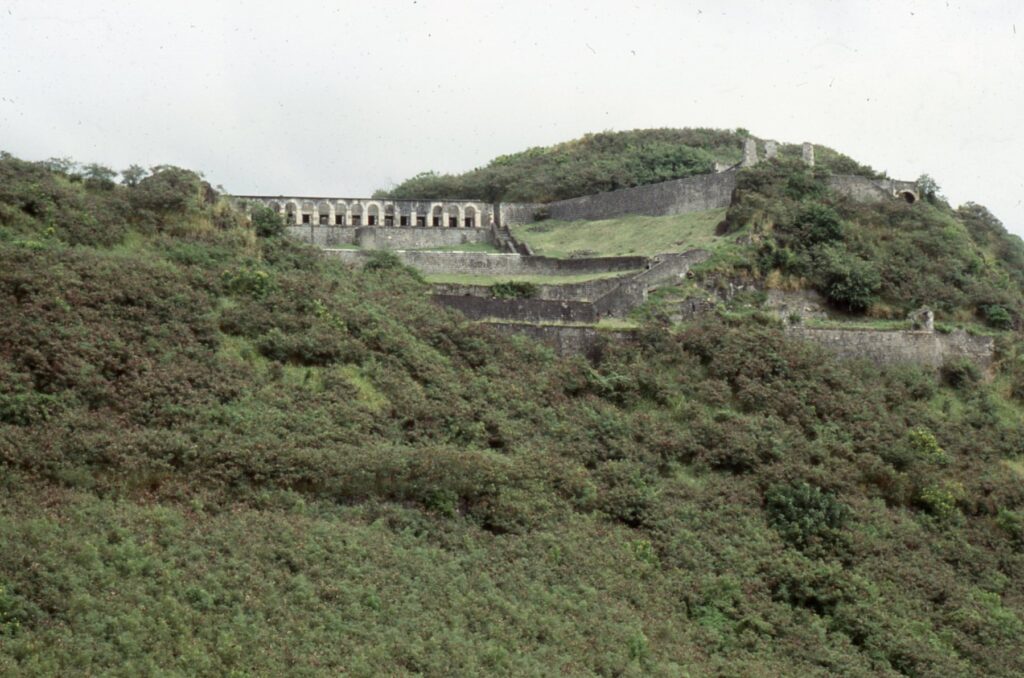
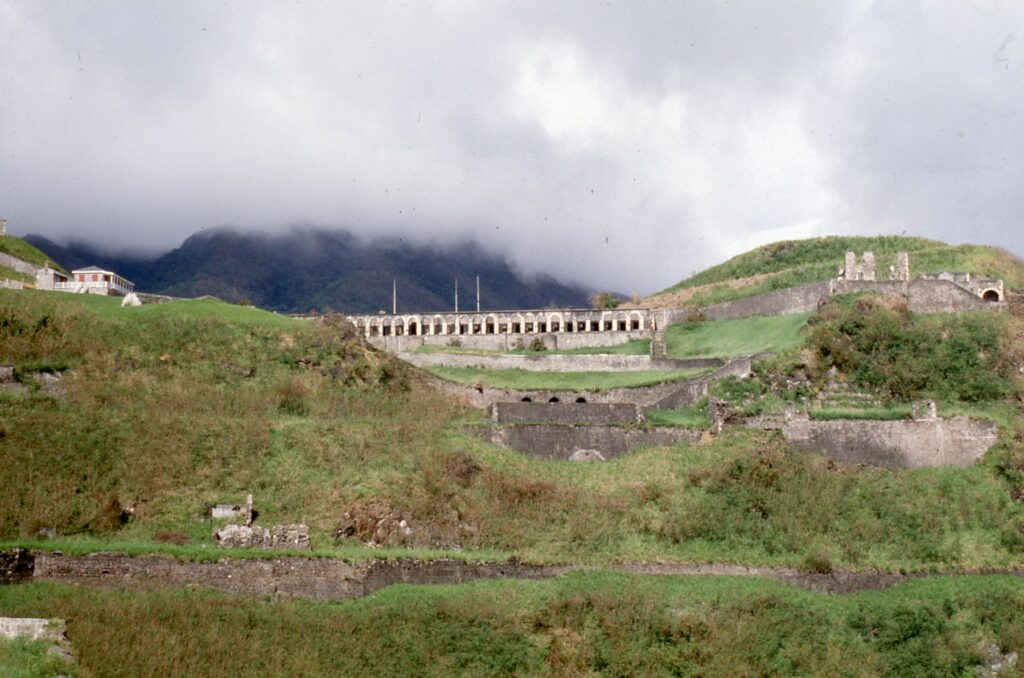 The courtyard and gundeck were, collectively, big enough to accommodate the entire company of soldiers on duty at Brimstone Hill. This was seen as a good thing by the commanding officers because it allowed for all to be present during any punishments to be meted out. The entire company would be assembled on the gundeck above and the courtyard below and the unlucky fellow(s) placed in the middle of the courtyard, where everyone could see. Floggings were the usual punishment of the day.
The courtyard and gundeck were, collectively, big enough to accommodate the entire company of soldiers on duty at Brimstone Hill. This was seen as a good thing by the commanding officers because it allowed for all to be present during any punishments to be meted out. The entire company would be assembled on the gundeck above and the courtyard below and the unlucky fellow(s) placed in the middle of the courtyard, where everyone could see. Floggings were the usual punishment of the day.
Two of the most memorable events of my time at Brimstone occurred in Fort George. In August of 1989, the well-known American actor, Danny Glover visited St. Kitts. A trip to Brimstone Hill was a must. He and his Kittitian entourage (Government officials and media folks) arrived one morning. I was his official host. To my great delight, he asked for a tour of Fort George-at the top of that long stairway. To my even greater delight, every single one of the folks in his escort declined to accompany us. As a result, I had a private, one-on-one, hour-long tour/conversation with Danny Glover!
The other event involved Chris Patten-the last British Governor of Hong Kong and the current Chancellor of Oxford University. When he came to St. Kitts, he was the Minister of Overseas Development in Margaret Thatcher’s Government. Mr. Matheson, my supervisor and head of the Brimstone Hill Society, was his guide and host. I accompanied them in my role as Park Manager. We had several different brochures/publications for the Park and Mr. Matheson was enthusiastically sharing and explaining each to Mr. Patten. Handing the next one to Mr. Patten, Mr. Matheson opened the cover…and out jumped a scorpion! Manager Shipe to the rescue as I quickly squished the agitated arachnid underfoot. Fortunately, Mr. Patten had a sense of humor and was able to laugh it off, but Mr. Matheson could only think that he had almost killed the Minister of Overseas Development!
If you are visiting on an especially clear day, be sure to stop again at the Western Place of Arms, because you might be fortunate enough to see the seven islands visible from the Hill. To the northwest are Statia, Saba, St. Martin, and St. Barts. And off to the southeast are St. Kitts’ sister island of Nevis, plus Montserrat and Antigua.
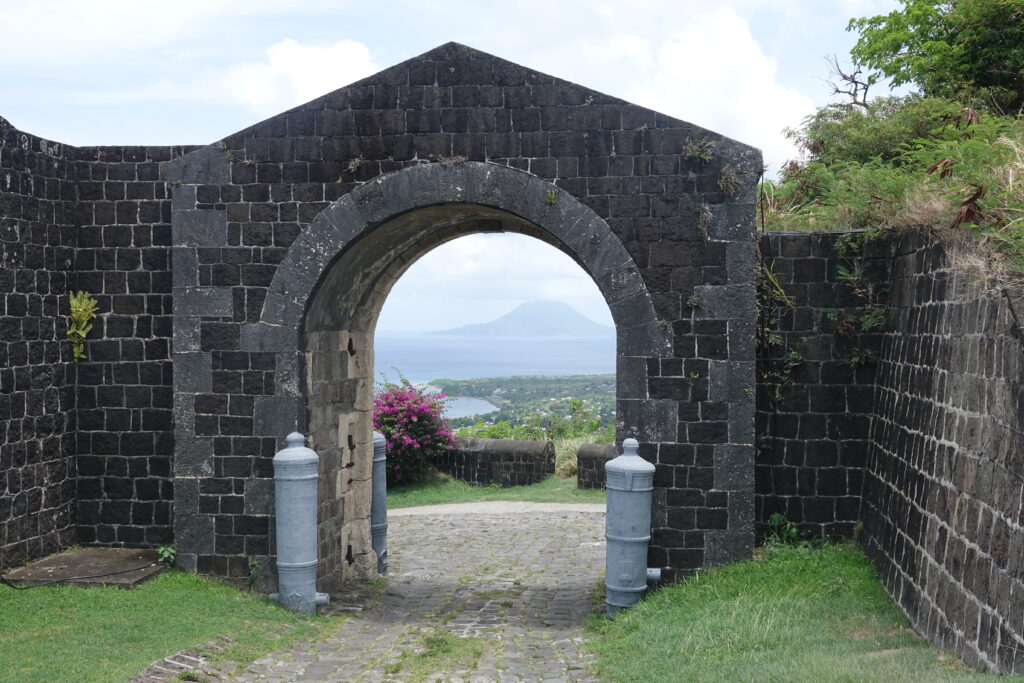
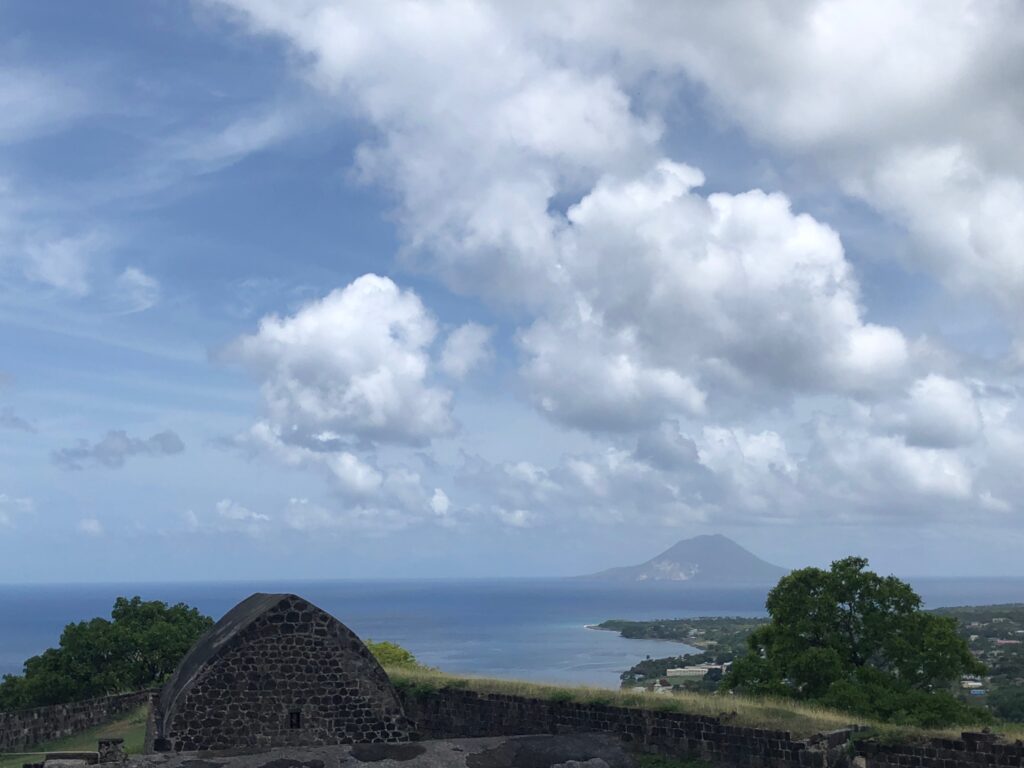 Back down on the Parade Ground are a wide array of ruins and reconstructed buildings plus a stage at the far end nestled into the hillside of where Fort Charlotte would have been. Since it was never constructed, it is most widely known as Monkey Hill. We also cleared the trees from it while I was there and discovered that some initial stonework had in fact been started. A sloping road that wound up and around to the summit (again, to allow for easy transport of cannons) was bordered on the inside by a low retaining wall. Off the back side, we rediscovered a covered lookout/gun emplacement that faced towards Liamuiga.
Back down on the Parade Ground are a wide array of ruins and reconstructed buildings plus a stage at the far end nestled into the hillside of where Fort Charlotte would have been. Since it was never constructed, it is most widely known as Monkey Hill. We also cleared the trees from it while I was there and discovered that some initial stonework had in fact been started. A sloping road that wound up and around to the summit (again, to allow for easy transport of cannons) was bordered on the inside by a low retaining wall. Off the back side, we rediscovered a covered lookout/gun emplacement that faced towards Liamuiga.
The Parade Ground is the literal end of the road and is where all taxis/tour buses park. The information area and souvenir shop are housed in the reconstructed storehouse, and is part of a small complex that also includes the rebuilt Quartermaster’s Quarters and its separate kitchen. They have been furnished in period pieces as you look in. The Canteen is the final rebuilt building on the Parade Ground where you can grab a cold beer or soda, hamburger, or chicken and chips. It is run by Ian Saunders-now there for over 35 years.
As cool and as reflective of history as these reconstructed buildings are, the ruins are possibly even more attractive. Because, in addition to seeing history, the ruins also allow your imagination to run wild. Exploring the empty rooms of the Infantry Officers’ Quarters or the skeletal remains of the Artillery Officers’ Quarters are quite memorable. I especially enjoy venturing down the almost hidden steps behind the Artillery Officers’ Quarters to end up at their private necessary. Probably one of the most stunning views for a bathroom anywhere in the Caribbean.
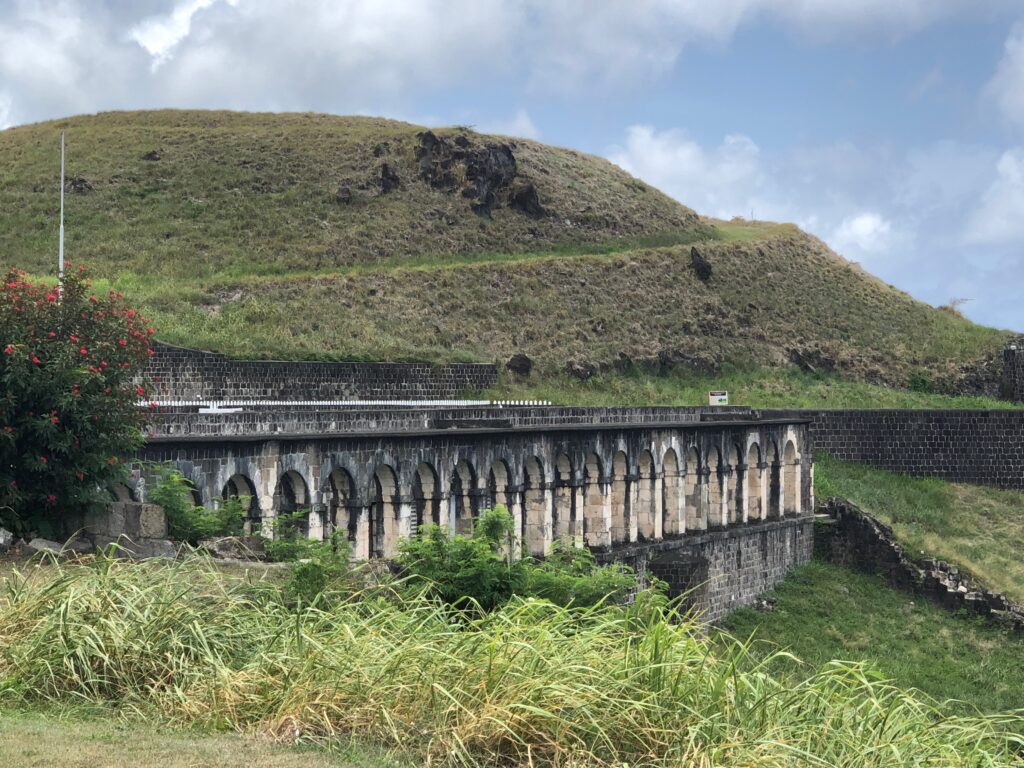
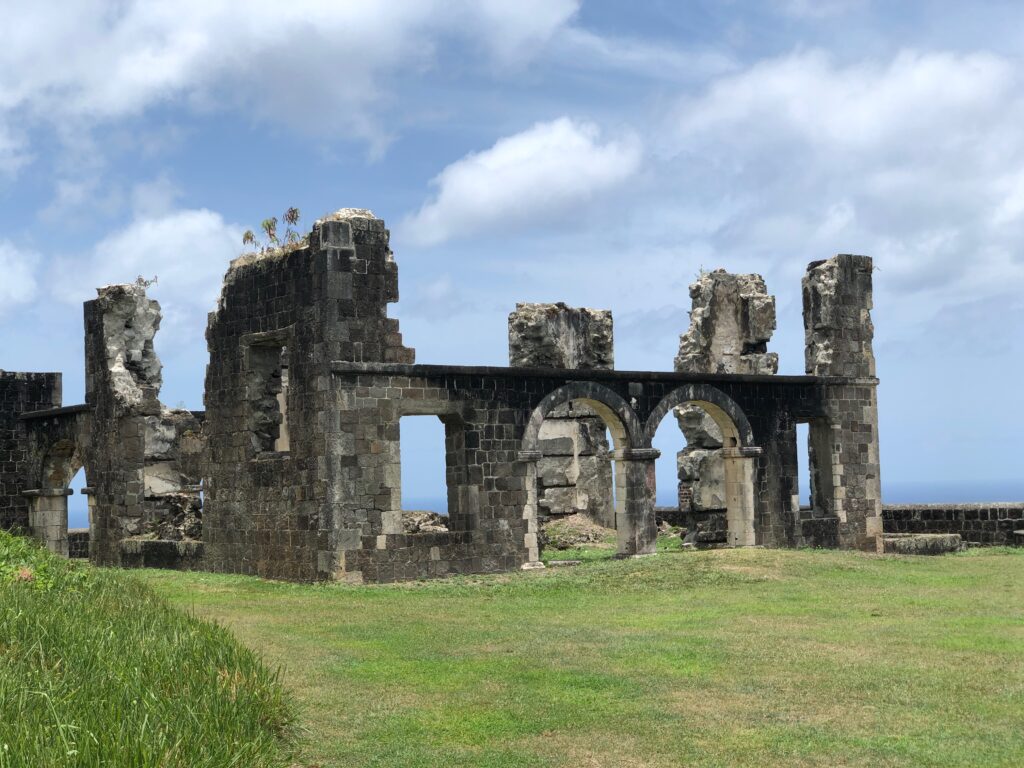 If you really want to let your imagination go, then you should wander through the ruins of the Jumbie Barracks. Jumbie is the West Indian term for ghost. Yes, these are haunted barracks! Many swear to the frequent appearance of a redcoat wearing soldier on sentry duty amongst the ruins. At dusk or on foggy days are the best times to see him.
If you really want to let your imagination go, then you should wander through the ruins of the Jumbie Barracks. Jumbie is the West Indian term for ghost. Yes, these are haunted barracks! Many swear to the frequent appearance of a redcoat wearing soldier on sentry duty amongst the ruins. At dusk or on foggy days are the best times to see him.
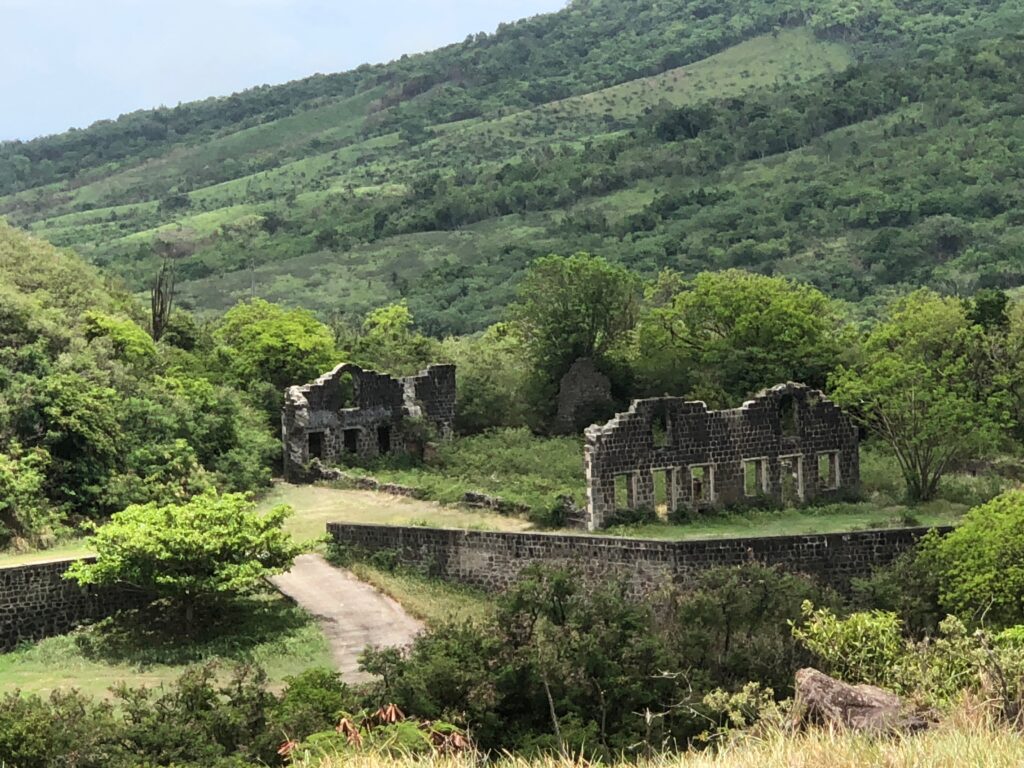 A short, easy walk down the entry road brings you to the imposing Prince of Wales Bastion. It protects the last section of where the road passes through the wall. You’ll note inverted cannons here too, this time to protect the archway stones from poor wagon drivers (and now taxi drivers). This bastion is reminiscent of the prow of a ship and from certain perspectives you see the bow and only the blue Caribbean before it. The most impressive of the 60-some known soldier created graffiti is found here. It is of an 18th century sailing ship. The Prince of Wales Bastion is my favorite of all the structures on the hill because it also housed my office!
A short, easy walk down the entry road brings you to the imposing Prince of Wales Bastion. It protects the last section of where the road passes through the wall. You’ll note inverted cannons here too, this time to protect the archway stones from poor wagon drivers (and now taxi drivers). This bastion is reminiscent of the prow of a ship and from certain perspectives you see the bow and only the blue Caribbean before it. The most impressive of the 60-some known soldier created graffiti is found here. It is of an 18th century sailing ship. The Prince of Wales Bastion is my favorite of all the structures on the hill because it also housed my office!

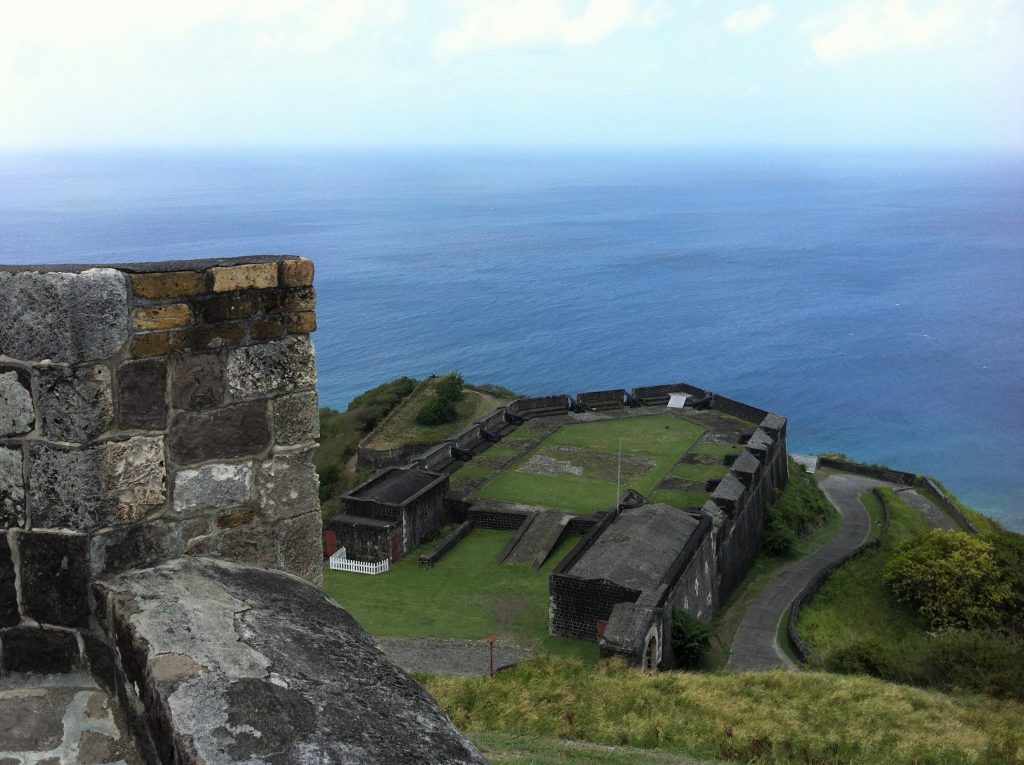
 Back up on the Parade Ground and now standing on the roof/floor of the Infantry Officers’ Quarters and looking to the southwest is a most amazing view of the Eastern Caribbean. But if you cast your gaze down you see a massive, fan-shaped, paved catchment area, reminiscent of a glacial cirque. All rainwater falling on it was captured and diverted into three immense underground tanks. At the far end of the Infantry Officer’s Quarters, and before you reach the Artillery Officer’s Quarters, you encounter the top of a long flight of stairs. These are the so-called 100 Steps (there are actually 105, but that doesn’t sound as romantic). The stairs end at the level of the former private residences, additional military housing, and the Orillon Bastion. This was the main magazine for the fortress. Walking onto the grass-covered bastion, you’ll notice some scattered ruins to your left. This is all that remains of the fortress’ hospital. It is located just above the start of the Orillon. In one of the better ironies I’ve ever encountered, just below the hospital, at the base of the wall, is a cemetery!
Back up on the Parade Ground and now standing on the roof/floor of the Infantry Officers’ Quarters and looking to the southwest is a most amazing view of the Eastern Caribbean. But if you cast your gaze down you see a massive, fan-shaped, paved catchment area, reminiscent of a glacial cirque. All rainwater falling on it was captured and diverted into three immense underground tanks. At the far end of the Infantry Officer’s Quarters, and before you reach the Artillery Officer’s Quarters, you encounter the top of a long flight of stairs. These are the so-called 100 Steps (there are actually 105, but that doesn’t sound as romantic). The stairs end at the level of the former private residences, additional military housing, and the Orillon Bastion. This was the main magazine for the fortress. Walking onto the grass-covered bastion, you’ll notice some scattered ruins to your left. This is all that remains of the fortress’ hospital. It is located just above the start of the Orillon. In one of the better ironies I’ve ever encountered, just below the hospital, at the base of the wall, is a cemetery!
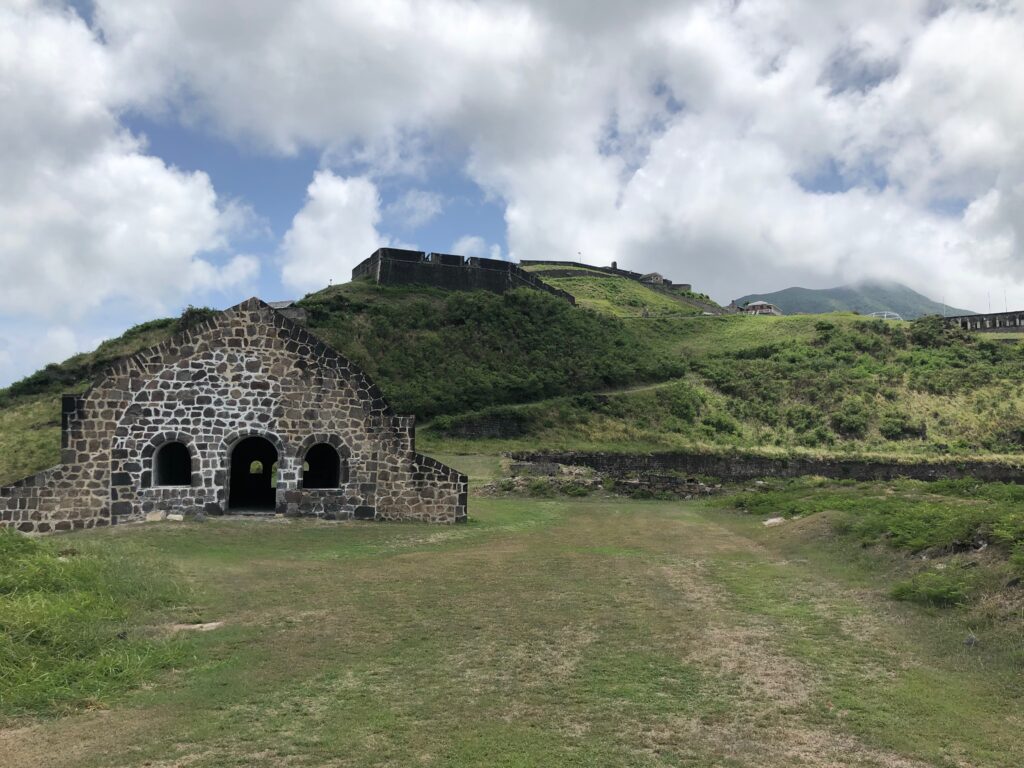
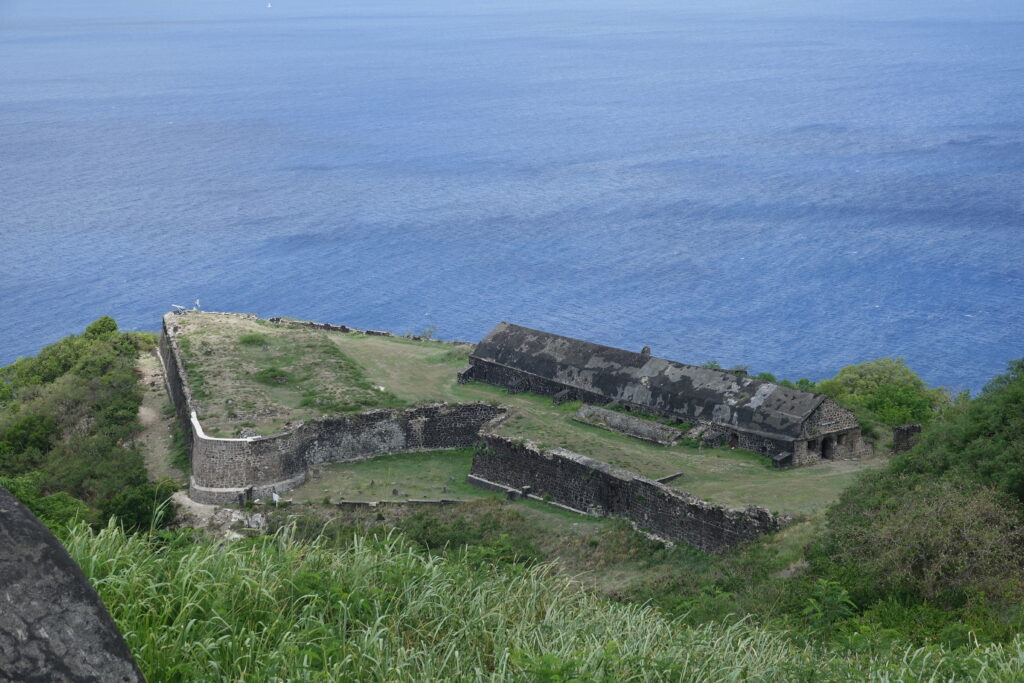 This is just the enlisted men’s cemetery. There is a separate, non-commissioned officers cemetery on the opposite side of the bastion. Finally, if you were an officer and had the bad fortune of dying, you were buried in the Anglican Church cemetery in the nearby town of Sandy Point. Don’t you just love those class-conscious Brits? Be sure take the time to wander through and read the tombstones in the enlisted men’s cemetery. There is one unfortunate wife who died at age 29, having given birth to 10 children!
This is just the enlisted men’s cemetery. There is a separate, non-commissioned officers cemetery on the opposite side of the bastion. Finally, if you were an officer and had the bad fortune of dying, you were buried in the Anglican Church cemetery in the nearby town of Sandy Point. Don’t you just love those class-conscious Brits? Be sure take the time to wander through and read the tombstones in the enlisted men’s cemetery. There is one unfortunate wife who died at age 29, having given birth to 10 children!
 A further short walk down the entry road brings you to the Magazine Bastion, the first large structure on the hill. It housed the original magazine and was again designed to capture rainwater and collect it into a nearby underground tank.
A further short walk down the entry road brings you to the Magazine Bastion, the first large structure on the hill. It housed the original magazine and was again designed to capture rainwater and collect it into a nearby underground tank.
Needless to say, even though it has been 34 years since I worked there, it left a big and lasting impression on me. I am always happy to talk about the fortress and my experiences there. I thank you most sincerely for your patience in wading through my deep and lasting memories!

